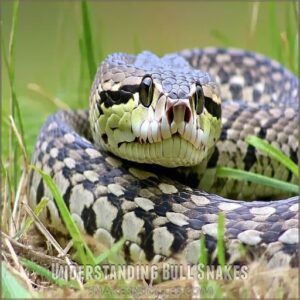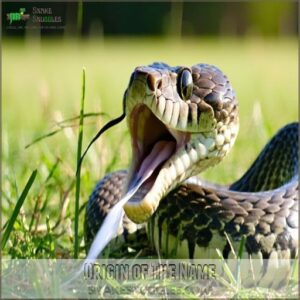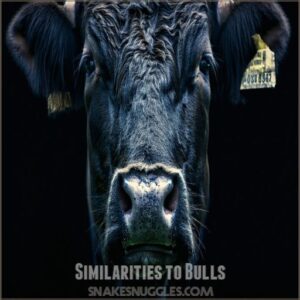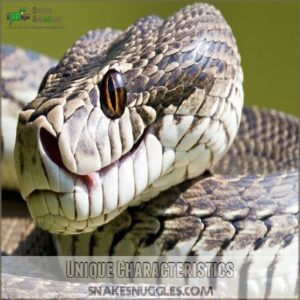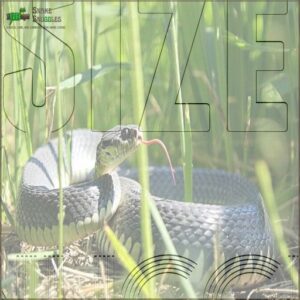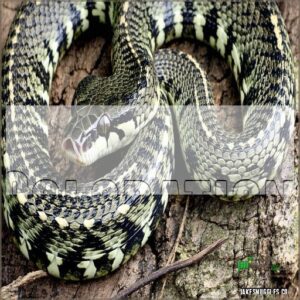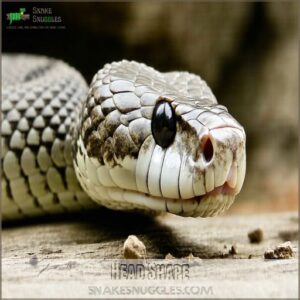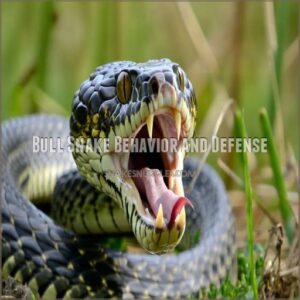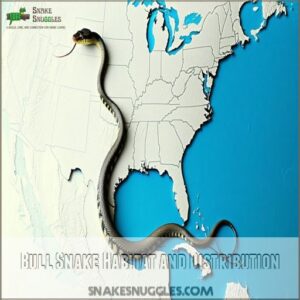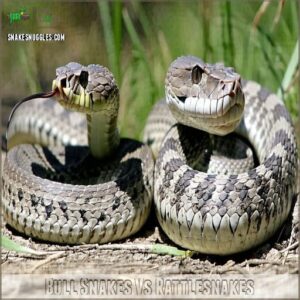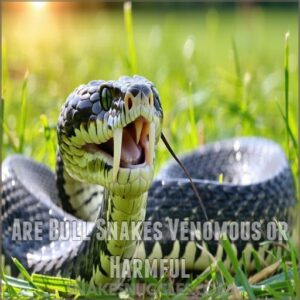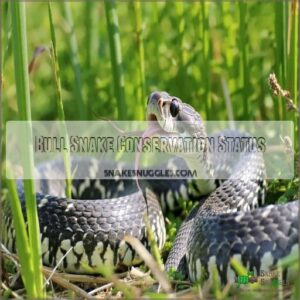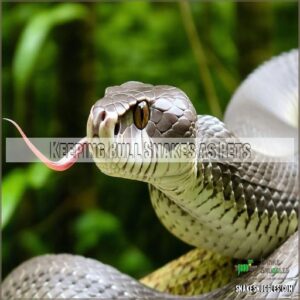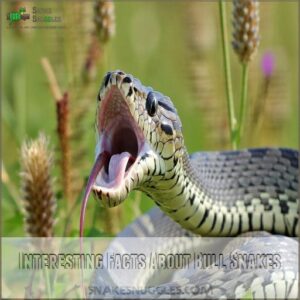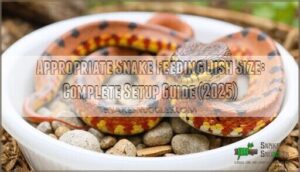This site is supported by our readers. We may earn a commission, at no cost to you, if you purchase through links.
 You’ve probably wondered why it’s called a bull snake, and the answer lies in its impressive size and behavior.
You’ve probably wondered why it’s called a bull snake, and the answer lies in its impressive size and behavior.
These powerful constrictors, reaching up to 8 feet long, earned their name from their bull-like defensive display.
When threatened, they’ll puff up their thick bodies and release loud, raspy hisses that sound remarkably similar to a bull’s snort.
Their stout build and muscular neck also contribute to this bovine comparison.
Despite their intimidating name and size, these non-venomous snakes are actually nature’s best pest controllers, with some fascinating tricks up their scales for dealing with unwanted rodents.
Table Of Contents
- Key Takeaways
- Understanding Bull Snakes
- Why is It Called a Bull Snake
- Bull Snake Physical Characteristics
- Bull Snake Behavior and Defense
- Bull Snake Habitat and Distribution
- Bull Snakes Vs Rattlesnakes
- Are Bull Snakes Venomous or Harmful
- Bull Snake Conservation Status
- Keeping Bull Snakes as Pets
- Interesting Facts About Bull Snakes
- Frequently Asked Questions (FAQs)
- Why is it called a bull snake?
- What type of snake is a bullsnake?
- Is a bull snake a king snake?
- Are gopher snakes the same as bull snakes?
- Are bull snakes venomous?
- What is a bullsnake called in Mexico?
- What is the real name of the bull snake?
- How poisonous is a bull snake?
- Will bull snakes eat rattlesnakes?
- What’s the difference between a bull snake and a gopher snake?
- Conclusion
Key Takeaways
- You’ll recognize where the bull snake’s name comes from – they make a loud, raspy hiss that sounds remarkably like a bull’s snort when threatened.
- You can identify these non-venomous constrictors by their impressive size of up to 8 feet long and their stout build with a muscular neck, adding to their bull-like appearance.
- You’ll find they use their bull-like defensive display strategically – they puff up their bodies and release loud hisses to mimic more dangerous snakes like rattlers.
- You’ll notice they’re excellent pest controllers despite their intimidating name, using their powerful constricting abilities to hunt rodents and maintain ecological balance.
Understanding Bull Snakes
If you’ve ever wondered why these impressive reptiles are called bull snakes, it helps to first understand their physical characteristics, habitat, and dietary habits.
These snakes, known for their burly build and earthy coloration, thrive across a wide range of North American environments, preying on small mammals, birds, and even insects while occasionally imitating the more intimidating rattlesnake.
Physical Description
Bull snakes, hefty constrictors, typically measure three to five feet long.
Their coloration? A beige to light brown canvas splashed with dark brown or black blotches. You’ll notice a yellowish belly speckled with black.
Their heads are relatively small compared to their bodies, a key feature differentiating them from some other snakes.
Their enlarged nose shields hint at their burrowing habits – a neat trick for finding tasty meals!
These snake characteristics contribute to their unique appearance.
Habitat and Range
Exploring the realm of bull snakes, you’ll find them across vast terrains. They’ve spread their range from southern Canada through the central United States.
These non-venomous snakes adapt to diverse environments.
What’s fascinating? 1. Preferred climates vary but often skew dry.
- Bull snake migration patterns shift with the seasons.
- Geographic variations in habitat are evident, particularly between regions.
Behavior and Diet
After considering their preferred habitats, one can’t ignore bull snake behavior and diet.
These snakes are experts at ambush, preferring small mammals and birds as their main food sources.
Their defensive tactics mimic rattlesnakes, adding drama to their persona.
While chasing prey, agile moves make them impressive hunters.
With gopher snake similarities, they’re misunderstood but essential pest controllers.
Why is It Called a Bull Snake
You’re probably wondering why it’s called a bull snake, and the answer lies in its impressive vocal mimicry, making a sound strikingly similar to a bull’s snort.
This name reflects both its unique hissing ability and the bold, robust presence these snakes exhibit when threatened.
Origin of The Name
Curiously, the moniker "bull snake" originates from the sounds these serpents make.
Like a brass section tuning up, their hissing closely mimics a bull’s snort, which captured the ears of early observers.
This etymological journey combines snake names and historical records, weaving through the lineage of Pituophis catenifer, often confused with its close cousin, the gopher snake.
Similarities to Bulls
So, the name "bull snake"—where’d that come from? It’s not about horns or hooves, but sound! Think of its loud hissing, a sound like a bull snorting. That’s the core connection.
Here’s what makes it bull-like:
- A heavy build—it’s a chunky snake.
- Ground dwelling—it’s not a tree climber.
- Strong constrictors—it’s not a venomous snake.
- Its impressive size.
Unique Characteristics
Bull snakes, renowned for their remarkable defensive tactics, showcase an interesting array of characteristics.
Their scales and patterns, along with their hissing sound, often confuse them with the venomous rattlesnakes.
Their adept digging abilities and impressive body size allow them to thrive in diverse habitats.
The name "bull snake" reflects their loud hissing, reminiscent of a bull’s snort.
Bull Snake Physical Characteristics
When you encounter a bull snake, you’ll notice its impressive size, typically stretching between three to five feet, adorned with distinctive dark blotches on a beige or light brown background.
Its head is small and features a unique, enlarged nose shield, perfect for digging and matching its robust, constrictor body.
Size
You’re curious about the bull snake’s size, right?
Typically, these hefty snakes stretch between three to five feet, though some giants reach eight feet, showing impressive growth rates.
This size variation is striking, especially when compared to their cousins, the gopher snakes. Pituophis catenifer, these snakes’ massive size guarantees they stand out in snake-characteristics conversations.
Coloration
Imagine a snake sporting a unique coat—a bull snake’s coloration showcases beige to light brown hues with dark blotches.
These color variations, driven by regional differences and age-related changes, provide excellent camouflage.
This natural disguise helps them blend seamlessly into their environment, echoing the diverse palettes found in Pituophis catenifer populations.
Some exhibit melanism, creating a striking look. And are also notable in the Bullsnake vs Gopher snake comparison.
Head Shape
With head shape, bull snakes showcase a unique identity. Their heads are surprisingly small relative to their hefty bodies and round in shape.
You’ll observe distinct patterns on their head scales.
For those interested in more specific details, the bull snake snout shape is an interesting topic to explore through Bull Snake Accessories.
The head width is less intimidating than you’d think, with snout shapes varying slightly among individuals.
These features contribute to their impressive snake morphology, adding charm to Pituophis melanoleucus.
Bull Snake Behavior and Defense
When you encounter a bull snake, you’re witnessing a master of self-defense, renowned for mimicking a rattlesnake by hissing loudly and shaking its tail to deter potential threats.
These nonvenomous constrictors are adept hunters, using their strength to overpower prey.
They also play an important role in their ecosystem by controlling rodent populations.
Defensive Mechanisms
Their impressive size and coloration aren’t their only defenses. Bull snakes are masters of defensive mimicry, employing a clever arsenal to deter predators. Think of it as their ultimate bluff!
- They inflate their bodies to appear larger and more threatening.
- A loud hiss, like a bull snorting, adds to the intimidation.
- They vibrate their tails, mimicking a rattlesnake’s rattle.
- A strike, though usually a bluff, adds to the show.
These impressive displays, along with their powerful constricting abilities, help them survive in the wild. Understanding their defenses can help you appreciate these fascinating creatures.
Diet and Hunting
Eating anything from rodents to eggs, bull snakes use ambush tactics to snag prey. They tightly coil around their catch, showing off constriction skills honed by nature.
Their swallowing process is oddly fascinating, unhinging jaws for a meal.
A bull snake’s digestive system efficiently breaks down big bites, fueled by their diverse diet, including a variety of small mammals and birds.
Curious? See their prey menu below:
| Prey Type | Hunting Technique | Swallowing Process | Digestive Fun |
|---|---|---|---|
| Rodents | Ambush | Jaw Unhinging | Efficient |
| Birds | Stalking | Gulping | Thorough |
| Eggs | Snatching | Cracking | Nutrient-rich |
| Insects | Quick Strike | Fast Intake | Swift |
Interaction With Humans
Despite their intimidating size and defensive displays, bull snakes generally maintain peaceful interactions with humans when left undisturbed.
- They prefer flight over fight, quickly retreating when possible
- Defensive hissing serves as a warning signal
- Bites occur only when cornered or handled roughly
- Most encounters end peacefully when given space
Bull Snake Habitat and Distribution
You’ll find bull snakes thriving across North America’s diverse landscapes, from the sun-baked prairies of the Midwest to the rugged terrain of the Rocky Mountains.
While they’re most commonly spotted in the central United States,
you can observe these adaptable reptiles in various habitats, including grasslands, woodlands, and even agricultural areas where they help control rodent populations.
Bull snakes are found across North America.
Native Range
Across North America, you’ll find bull snakes thriving in diverse regions, from the rolling plains of Texas to the rugged landscapes of Montana.
| Region | Population Density | Range Status |
|---|---|---|
| Central US | High | Stable |
| Midwest | Moderate | Expanding |
| Rocky Mountains | Low | Declining |
These adaptable serpents have historically inhabited regions stretching from southern Canada to central Mexico.
Preferred Environments
When seeking their ideal home, bull snakes gravitate to open grasslands, prairies, and semi-arid regions with loose, sandy soil.
You’ll find these impressive reptiles thriving in areas with abundant rodent populations, particularly where gophers make their burrows.
They’re comfortable in both lowland meadows and rocky hillsides, preferring spots with scattered vegetation that provides cover while allowing them to bask in the sun.
Adaptation to Different Habitats
Bull snakes showcase remarkable adaptability across diverse environments, from arid deserts to grassland prairies.
You’ll find these resourceful reptiles modifying their behavior based on local conditions – they’ll burrow deeper in extreme temperatures and adjust their hunting patterns based on available prey.
Their success stems from their ability to thrive in both disturbed and natural habitats, making them one of North America’s most versatile snakes.
Bull Snakes Vs Rattlesnakes
You’ll often spot bull snakes mimicking rattlesnakes by puffing up their bodies and shaking their tails, making them tricky to tell apart at first glance.
While both species share similar defensive behaviors, you can identify a bull snake by its pointed tail, round pupils, and the absence of heat-sensing pits between its eyes and nostrils.
Similarities and Differences
Distinguishing between rattlesnakes and bull snakes can be challenging due to their striking similarities.
While both species share habitat preferences and defensive behaviors, here are key differences:
- Tail structure (rattlers have segments, bull snakes don’t)
- Head shape (rattlers have triangular heads, bull snakes have rounded ones)
- Pupil shape (rattlers have vertical slits, bull snakes have round pupils)
- Body thickness (rattlers are stockier, bull snakes are more slender)
How to Distinguish Between Them
At first glance, telling apart these serpentine cousins can seem challenging.
Here’s a clear breakdown of their physical differences:
| Feature | Bull Snake | Rattlesnake |
|---|---|---|
| Head Shape | Narrow, rounded | Broad, triangular |
| Tail End | Pointed tip | Distinct rattle |
| Eye Shape | Round pupils | Vertical pupils |
| Scale Pattern | Smooth, glossy scales | Keeled, rough scales |
These physical markers help you make a safe, accurate identification when you encounter either species in the wild.
Comparison of Behavior
While both species display defensive behaviors, they approach threats differently. You’ll notice these key behavioral distinctions:
- A rattlesnake’s tail shake produces a crisp, distinct rattle, while bull snakes create a softer sound by brushing their tail against leaves
- Bull snakes actively pursue prey into burrows; rattlers ambush from concealed positions
- Rattlers strike and retreat; bull snakes constrict
- Bull snakes are diurnal hunters; rattlesnakes prefer dawn and dusk
Are Bull Snakes Venomous or Harmful
You’ll be relieved to know that bull snakes don’t possess venom glands and won’t cause serious harm to humans.
While they might bite if they feel threatened, their bite isn’t poisonous and typically causes only minor discomfort, similar to a cat scratch.
Non-Venomous Nature
Unlike their rattlesnake lookalikes, bull snakes don’t pack any venom at all.
They’re members of the Colubridae family, known as harmless constrictors that use their muscular bodies to subdue prey.
You’ll be relieved to know that these impressive reptiles rely on squeezing rather than toxic proteins to catch their dinner, making them completely safe from a venom perspective.
Potential Threats to Humans
Though bull snakes aren’t venomous, they can still pose certain risks to humans.
Here’s what you should know about potential threats:
- Their bite contains bacteria that may lead to infections if left untreated
- Large adults have strong jaws that can deliver painful bites
- They’ll defend themselves if they feel cornered or threatened
- Their intimidating size and hissing display can cause anxiety in some people
Stay calm if you encounter one – they’re more interested in avoiding you than causing harm.
Constricting Ability
Despite being non-venomous, bull snakes are powerful constrictors that can exert significant force when subduing prey.
Their constricting technique is often compared to the products available for handling and caring for bull snakes, such as those found at Bull Snake Constrict Chewy.
Their muscle structure allows them to wrap tightly around their catch, typically small mammals or birds, and gradually increase pressure until breathing stops.
You’ll find their constricting technique particularly effective, as they can compress their prey with enough force to restrict blood flow while maintaining their own energy efficiency.
Bull Snake Conservation Status
You’ll be relieved to know that bull snakes aren’t currently listed as endangered or threatened in North America.
While these beneficial predators face challenges from habitat loss and road mortality, you can help protect them by supporting local conservation efforts and practicing snake-friendly landscaping in your yard.
Current Threats
Habitat loss poses a significant challenge for bull snakes as urban development swallows up their natural environments.
Climate change disrupts their breeding cycles and food availability.
Pesticide use in agricultural areas has decimated their prey populations, while road mortality and deliberate killing due to misidentification as rattlesnakes continue to impact their numbers considerably.
Conservation Efforts
Three key conservation efforts are helping protect bull snake populations across North America.
Wildlife agencies have implemented strict regulations against capturing wild specimens, while habitat restoration projects focus on preserving grasslands and prairies.
Many organizations and individuals also support conservation through purchasing products from websites dedicated to Bull Snake Merchandise.
You’ll find dedicated conservation groups working to educate communities about these beneficial predators, dispelling myths and promoting coexistence.
Additionally, scientific research programs track population trends and study their ecological roles.
Importance of Preservation
Beyond established conservation efforts, preserving bull snake populations plays a significant role in maintaining nature’s delicate balance.
You’ll find these remarkable creatures contribute to our ecosystem in three key ways as they hunt for their primary prey like gophers and mice.
They control rodent populations that damage crops and spread disease.
They maintain biodiversity in grassland ecosystems.
They serve as indicator species for habitat health.
Every bull snake saved helps protect our agricultural lands and natural spaces.
Keeping Bull Snakes as Pets
You’ll find that bull snakes can make fascinating pets once they’ve become accustomed to regular handling, thanks to their generally docile nature and impressive size range of three to five feet.
While they’re not aggressive toward humans, you’ll need to understand their specific care requirements, including proper housing, temperature control, and feeding schedules, to make sure your bull snake thrives in captivity.
Pros and Cons
When considering a bull snake as a pet, it’s important to weigh the benefits against potential drawbacks.
Here’s a detailed breakdown to help you make an informed decision:
| Aspect | Pros | Cons |
|---|---|---|
| Maintenance | Low-maintenance pet | Requires specific temperature control |
| Temperament | Generally docile | Can be defensive initially |
| Space | Minimal space needed | Needs secure enclosure |
| Cost | Affordable compared to other pets | Initial setup costs can be high |
| Interaction | Long lifespan (15-20 years) | Limited emotional bonding |
Care and Maintenance
Taking care of a bull snake requires proper housing and a consistent feeding schedule.
Your snake’s enclosure should maintain temperatures between 75-85°F with a basking spot of 90°F. You’ll need a spacious enclosure, as adults can reach up to 8 feet long, which is why a 4x2x2 foot vivarium is recommended.
Here’s what you’ll need for good care:
- A secure 40-gallon terrarium with proper ventilation
- UVB lighting for natural behavior patterns
- Multiple hiding spots using cork bark or commercial hides
- A substrate that holds moisture, like coconut fiber
Remember, maintaining humidity between 30-50% helps make sure successful shedding cycles.
Handling and Safety
Safe handling of bull snakes requires patience and proper technique.
You’ll want to support their entire body while keeping a firm but gentle grip near the head and midsection.
Though nonvenomous, their bites can still hurt and may cause infection, so always wash your hands before and after handling.
Remember, these powerful constrictors can reach impressive sizes, so maintain respect and caution during every interaction.
Interesting Facts About Bull Snakes
You’ll discover remarkable abilities of bull snakes, from their powerful constricting strength to their impressive size record of over 8 feet in Minnesota.
Bull snakes are easily recognized by their distinctive loud hissing sound, which resembles a bull’s snort.
Unique Abilities
Bull snakes possess remarkable abilities that set them apart from other constrictors. Beyond their impressive hissing that earned their name, these powerful snakes showcase extraordinary talents:
- They’re master excavators, using their reinforced snouts to dig complex burrow systems
- Their constricting force rivals that of much larger snakes, enabling them to subdue prey effectively
- They’ve perfected rattlesnake mimicry, down to the tail-shaking and head-flattening display
Adaptations and Features
Nature has gifted these remarkable snakes with specialized nose shields perfect for digging through soil and hunting prey underground.
Their physical characteristics, such as relatively large eyes and distinct heads with narrow necks, resembling gopher snakes, are likely adaptations for their burrowing lifestyle.
You’ll notice their incredible ability to mimic rattlesnakes through body puffing and tail vibration, keeping predators at bay.
Their muscular bodies allow them to be expert constrictors, while their mottled coloration provides excellent camouflage in various habitats, from grasslands to forest edges.
Record-Breaking Snakes
The record books showcase some remarkable achievements in the snake world, including the largest bull snake ever recorded in Minnesota at an impressive 8 feet 4 inches. Here are some notable snake records that’ll fascinate you:
- King snakes reign as the strongest constrictors, exerting 180 mm Hg of pressure
- Green anacondas hold the title for heaviest snake at 550 pounds
- Black mambas claim the deadliest reputation despite not being most venomous
- Minnesota’s champion bull snake stands as the longest documented specimen
Frequently Asked Questions (FAQs)
Why is it called a bull snake?
You’ll recognize these powerful snakes by their distinctive hissing sound that mirrors a bull’s snort.
That’s exactly why they earned their name – they make a loud, aggressive snorting noise when startled.
What type of snake is a bullsnake?
Bullsnakes are classified as a subspecies of gopher snakes, belonging to the Pituophis catenifer family.
They’re heavy-bodied constrictors that can grow up to five feet long, featuring distinctive beige coloring with dark blotches.
Is a bull snake a king snake?
No, a bull snake isn’t a king snake – they’re different species entirely.
While bull snakes belong to the Pituophis genus, king snakes are from the Lampropeltis family and are known for eating other snakes.
Are gopher snakes the same as bull snakes?
Technically speaking, they’re quite close – a bull snake is actually a subspecies of the gopher snake family.
While they share many traits, you’ll notice bull snakes are typically larger and make that distinctive bull-like snort.
Are bull snakes venomous?
You’re completely safe around these impressive constrictors – they don’t have any venom.
Bull snakes might look intimidating and can deliver a painful bite if provoked, they’re not venomous snakes.
What is a bullsnake called in Mexico?
In Mexico, bullsnakes are commonly known as ‘víbora sorda’. They’re closely related to the Mexican bullsnake (Pituophis deppei), which lives throughout central Mexico’s highlands and Sierra Madres.
What is the real name of the bull snake?
Professionally known as Pituophis catenifer sayi, your backyard buddy belongs to the Colubridae family. This powerful python-like pal earned its name from its distinctive bull-like hiss when threatened.
How poisonous is a bull snake?
Bull snakes aren’t poisonous at all – they’re completely non-venomous constrictors.
While their bite might hurt and could get infected from bacteria in their mouth, you won’t need antivenom or emergency care.
Will bull snakes eat rattlesnakes?
Slithering through their habitat like skilled hunters, bull snakes aren’t just tough – they’re natural predators of rattlesnakes.
They’ll constrict and devour rattlers, helping control venomous snake populations in your area.
What’s the difference between a bull snake and a gopher snake?
Technically speaking, they’re the same species – bull snakes are just a subspecies of gopher snakes.
You’ll notice they look similar, but bull snakes tend to be larger and make that distinctive snorting sound.
Conclusion
Now you understand why it’s called a bull snake – these remarkable reptiles earned their name through their impressive size and distinctive bull-like defensive display.
Whether you’re spotting one in your garden or learning about their important role in ecosystem management, these powerful constrictors deserve our respect and protection.
Their unique blend of intimidating presence and beneficial nature makes them fascinating creatures that continue to captivate both researchers and nature enthusiasts alike.
So next time you encounter one, appreciate its remarkable adaptations.

